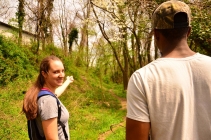
Courtesy of Tanvi Gadhia
Exploring historic Herbert Run
- BY RICHARD WILLIAMS
- • APRIL 21, 2016
The cold weather has finally broken and it’s safe to say that “spring” is finally here. You know what that means; it’s time to brace ourselves for finals, and miss out on spending quality time on Erickson field. But don’t overwork yourself, because with warm weather comes adventure.
Sarah Burton, an environmental tour guide, knows all of the nooks and crannies of UMBC’s natural scenery. The senior environmental studies major has been leading the UMBC Herbert Run hike since January, and she’s one of the best people to talk to about the history of the trail.
“I just started this year, but I’m frequently doing tours,” said Burton. “I guide usually over four times a semester.”
The hike started at the Joseph Bueys Sculpture Garden, and Burton surprised the tourists with a brief history of the area that most don’t know about. The garden consists of 30 oak trees and granite stones that were inspired by Bueys’ garden in his hometown of Castle, Germany.
“In Castle, Bueys and his community planted 7,000 oaks and rocks to reestablish the community and bring people together,” explained Burton.
The next stop was the Commons stream. The stream, which flows from around the Commons Garage and eventually to the Patapsco River and Cheseapeake Bay, is one of the most popular streams on the campus, but it is a bit in danger. Often times, students are found littering in the stream, which can be a hazard for animals within the ecosystem. But thanks to the Environmental Task Force, who comes out every Friday to clean up the garbage, the stream is improving.
Following the stream, the tour stopped by Giffen Hill. Giffen Hill, which rests behinds the UMBC Stadium Complex, has a bit of history behind it as well. From the 1870’s to 1930’s Giffen used to be a popular Baltimore farm, which later burned down and was reconstructed into a mental hospital. However, by the late 1960’s, UMBC purchased the land and tore-down the hospital. And even today, Giffen still faces a few issues. Since UMBC’s students never seem to find parking, the campus decided to turn the historic hill into a parking lot.
“The large white oak is over 200 years old and is a confirmed historic tree,” explained Burton with pride. “People have protested for this tree, and have even had the power to legally protect this tree from being torn down.”
The Conservation & Environmental Research Area was the next stop on the trail. This protected section of forest is home to a large portion of the campus’s animal and wildlife population. On certain trees, you can see engravings done by male deer, who scratch the bark with their antlers during mating season to attract mates.
“I see another one!” exclaimed Gadhia.
Tanvi Gadhia, an Enviornmental Sustainability coordinator, took detailed photos in CERA to capture its beauty. As a member of the campus environmental sustainability program, Gadhia manages to come to several eco-sustainability events on campus to expand the program. She also graduated from UMBC in 2009 with a B.A. in Environmental Studies.
Finishing off with Pig-Pen Pond and the boardwalk, Burton gave a brief history of Pig Pen, which began, quite surprisingly, as a pen for pigs. However, as decades wore on, the pen flooded into a pond, and today, geese and cranes relax in the murky waters.





